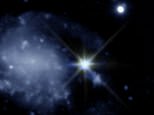Science
Scientists Trace Mysterious Deep Space Signal to Nearby Galaxy

A team of scientists has successfully traced the origin of a mysterious radio burst from deep space to an unknown object located in the nearby galaxy known as NGC 4141. This significant discovery was made by researchers from the Harvard & Smithsonian Center for Astrophysics and McGill University in Canada. The fast radio burst (FRB), designated as FRB 20250316A or ‘RBFLOAT,’ was detected in March 2025 and is one of the brightest of its kind, emanating from a location just 130 million light-years from Earth.
FRBs are brief but intense bursts of radio waves, lasting only a few milliseconds. They are believed to arise from extreme cosmic events, such as the explosive deaths of massive stars, which leave behind dense remnants known as magnetars. While many scientists have long theorized that these bursts could originate from natural phenomena, there has been speculation about the possibility of artificial signals from advanced extraterrestrial civilizations.
Using the James Webb Space Telescope (JWST), astronomers observed faint infrared light from the same area, which they have labeled NIR-1. This discovery may help identify the true source of the radio signal, offering a clearer understanding of the conditions that lead to such cosmic phenomena.
Breakthrough in Radio Astronomy
Mawson Sammons, a postdoctoral researcher at McGill University, highlighted the importance of this finding: “This marks the beginning of a new era where we can routinely localize even single, non-repeating bursts to pinpoint precision. That’s a game-changer for understanding what’s behind them.” The ability to accurately localize FRBs enhances the prospects of determining their origins and the astrophysical processes responsible for their generation.
The signal was traced back to an area in NGC 4141, which is positioned in the direction of the Big Dipper constellation. This area, approximately the size of a star cluster, holds the potential for revealing new astronomical insights. Previous FRBs detected by scientists have typically originated from billions of light-years away, making this nearby source particularly valuable for ongoing research.
The breakthrough was made possible by the Canadian radio telescope known as CHIME, which specializes in capturing these fleeting radio bursts. Recent upgrades to CHIME included the addition of ‘outrigger’ telescopes distributed across North America, from British Columbia to California. This network significantly improved the accuracy of pinpointing the origin of the signal, akin to identifying a coin from a distance of 130 miles.
Potential Sources and Implications
Following the detection of the burst, researchers utilized the JWST to capture detailed infrared images, revealing the faint object NIR-1, which could either be a local star or an entirely different astronomical entity. According to Edo Berger, a professor of astronomy at Harvard, “Being able to isolate individual stars around an FRB is a huge gain over previous searches and begins to tell us what sort of stellar systems could produce these powerful bursts.”
Theories regarding the cause of FRB 20250316A include the possibility of NIR-1 being a red giant star nearing the end of its life, which may harbor an unseen companion star like a magnetar. Alternatively, the FRB could have originated from a magnetar within a nearby cluster of young, massive stars, even if that magnetar itself remains undetectable from Earth. Another hypothesis suggests that the infrared light could be a fading ‘echo’ of the burst, rather than a star, warranting further observation to assess its behavior over time.
While FRBs are widely believed to be of natural origin, the potential for artificial signals from extraterrestrial beings remains a topic of intrigue. Currently, FRBs such as RBFLOAT have not exhibited any identifiable patterns or codes that would indicate intelligent communication.
Amanda Cook, a McGill-based postdoctoral researcher, remarked on the significance of the discovery: “This result marks a turning point: instead of just detecting these mysterious flashes, we can now see exactly where they’re coming from.” She added that this advancement opens up new avenues for exploration, allowing scientists to investigate whether these bursts are caused by dying stars, exotic magnetic objects, or even phenomena yet to be understood.
As research continues, the scientific community eagerly anticipates further investigations into the nature of these fast radio bursts and their implications for our understanding of the universe.
-

 Health3 months ago
Health3 months agoNeurologist Warns Excessive Use of Supplements Can Harm Brain
-

 Health3 months ago
Health3 months agoFiona Phillips’ Husband Shares Heartfelt Update on Her Alzheimer’s Journey
-

 Science2 months ago
Science2 months agoBrian Cox Addresses Claims of Alien Probe in 3I/ATLAS Discovery
-

 Science2 months ago
Science2 months agoNASA Investigates Unusual Comet 3I/ATLAS; New Findings Emerge
-

 Science1 month ago
Science1 month agoScientists Examine 3I/ATLAS: Alien Artifact or Cosmic Oddity?
-

 Entertainment5 months ago
Entertainment5 months agoKerry Katona Discusses Future Baby Plans and Brian McFadden’s Wedding
-

 Science1 month ago
Science1 month agoNASA Investigates Speedy Object 3I/ATLAS, Sparking Speculation
-

 Entertainment4 months ago
Entertainment4 months agoEmmerdale Faces Tension as Dylan and April’s Lives Hang in the Balance
-

 World3 months ago
World3 months agoCole Palmer’s Cryptic Message to Kobbie Mainoo Following Loan Talks
-

 Entertainment2 months ago
Entertainment2 months agoLewis Cope Addresses Accusations of Dance Training Advantage
-

 Science1 month ago
Science1 month agoNASA Scientists Explore Origins of 3I/ATLAS, a Fast-Moving Visitor
-

 Entertainment4 months ago
Entertainment4 months agoMajor Cast Changes at Coronation Street: Exits and Returns in 2025









